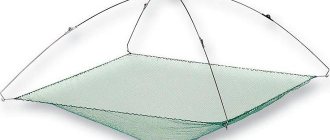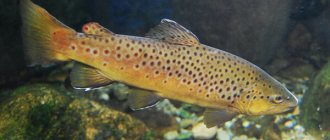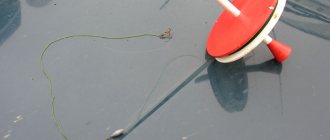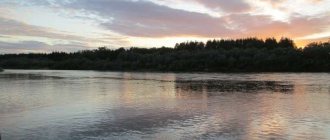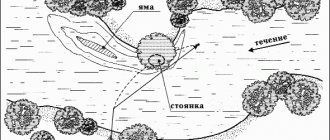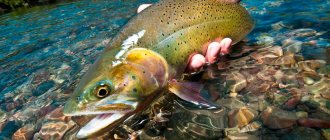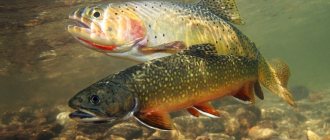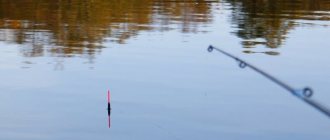Author: Gennady Shelyag
Brown trout on the Kola Peninsula are special. It’s hard to even remember how many times I had to watch a look full of hope and excitement - the expression on the fisherman’s face, from which, without any words, you could read everything that it expresses. Hunting for big fish here for a short time turns into the meaning of life. Try to answer the question - where, when, with what fly, in what weather, and at what time of day is there the greatest chance of catching a real trophy. Over many years of guiding the brown trout program, I have learned to answer these questions and give practical recommendations that work.
There can be no trifles here
To begin with, it’s worth understanding one thing that can be called key – there are and cannot be trifles in trout fishing. Once you decide that “this will do” because there is no other rod, line or, for example, leader material, you are on the road to failure. The same thing happens to those who believe that they already know everything and the only task is to get to a fresh place where no one has been for a long time. The most interesting thing is when someone who is not in a very good mood perceives all your advice and recommendations as a distraction and an excuse for the lack of the proper amount of fish in the river.
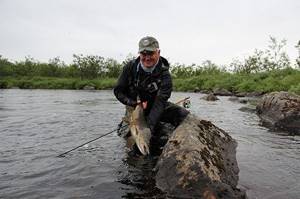
One of the conditions for catching trout is compactness.
So, first things first, let's start with the right equipment. Trout fishing is always a popular fishing activity. Therefore, the compactness and practicality of all components of your uniform is one of the necessary conditions. A small, compact waterproof backpack should be one that you don't feel on your shoulders, and that you can comfortably fish in without removing it from your shoulders. The need to leave your backpack on the shore and return for it creates a nuisance and interferes with the correct fishing process. You should not take heavy and bulky cameras, a large number of flyboxes, food and additional clothing. The optimal number of boxes with flies is 2 or 3.
Tackle for lake fishing on the Kola Peninsula

- You can equip the fishing rod with both a reel and a reel according to your personal taste. A good option would be to have anti-theft spokes. Char is not a cod, stunned by decompression, will actively try to escape.
–The choice of a bite alarm is also highly individual. If the temperature outside is below freezing, the floats will freeze. And with a positive signal, you can better see from the floats where the bites were. The choice is yours.
-The color of the fishing line to suit your taste. You can use a neutral color or transparent, or you can use black, which is clearly visible in the snow. Naturally, winter, maintaining elasticity in case of light frost. Thickness recommendations – 0.15 mm – 0.25 mm
–The most common spinner (spoon) is without a hook, tied above the bait. Typical size is 4-6 cm by 2-4 cm. Shape and color are not particularly important. The size, in general, is also not strict.
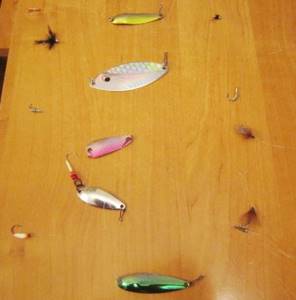
Glitter for lake fishing
– Either a fishing line or a special chain is used as a leash. The optimal length is 10-15 cm. The design looks like this: a carabiner in the upper ring, then a leash, then a hook from 6 to 10, preferably dark. With shiners, they usually use from one to three fishing rods, constantly playing.
–Also, as an option, you can use a tackle with a jig and a hook. We take a jig 1-2 cm, a hook 6-8. Next is a leash, about 20-30 cm, followed by a 6-10 hook. Some people use it without a leash, but we don’t recommend it.
Watch the video, which discusses in detail the gear (one of the options) used on our lake fishing trips.
-You can also make a garland. This is necessary to determine the fishing depth. To do this, hang a hook above the jig in increments of about a meter.
– If you have a stand-up fishing rod (color it brighter to see from afar), then you can do this: hang a pair of hooks No. 8-10 (short shank, medium wire) on the main line with a step of 30-40 cm. Between them there is a sinker 2 – 3 g. You can put 1-2 dozen of these fishing rods and lower the hook either to the very bottom, or put a load on the bottom if the fish is cautious. Such fishing rods must be fixed in the snow at the same time and not too loosely so that they are not blown away and not too tightly so that they fall in case of a bite. Also, if the fishing depth is shallow, then it is better to sprinkle the hole with snow so as not to irritate the fish with light.
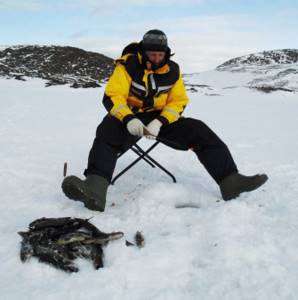
The process of catching red fish from the lake
Spikes - pros and cons when fishing for brown trout
It’s hard to imagine more comfortable and convenient waders for such fishing than the SIMMS G3 Stockingfoot. A good compact folding staff, SIMMS Wading Staff, will also be an indispensable assistant for you when moving and wading fishing. You should choose lightweight wader boots, and in most cases the sole on them is made of felt without spikes. However, if the water is “blooming” and there is a lot of algae on the underwater rocks, then you cannot do without thorns. It should be remembered that at low water levels when wading fishing, the spikes create additional noise, which scares away cautious fish.
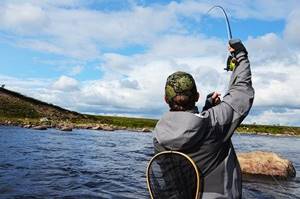
Don't be tempted!
The chances of catching large trout increase when using delicate gear. Class 4-5 rods with a classic length of 9 feet (2.7 m) are what you need. Do not use rods of higher classes, do not fall into the temptation of having a rod with a margin of strength and power. Without proper technique, this will not help you make longer casts or help you deal with larger fish. But splashing a larger cord through the water will help scare it away. Coarser shock absorption will not allow the use of thin leashes and the pleasure of landing large fish will sharply decrease. For me personally, the ideal rod for this type of fishing is the Redington Crux 590-4 single-handed rod. Digressing somewhat from the topic, I want to say that fly fishing equipment is something that must always be selected very precisely. Therefore, if you don’t have what you really need, then don’t buy anything. Just keep looking for what you need.
Don't get carried away with tapered leaders!
The main qualities of a fly line are its ability to break through the wind, make long casts and work with large streamers. It is difficult to find a cord that would satisfy all these qualities. The most suitable one can be considered RIO OutBond Streamer WF5F. Sinking leaders are used extremely rarely, so you don’t have to have them in your arsenal at all. Conical leaders and nylon leader material are only needed when fishing with dry flies using the dead swim method. In all other cases, it is better to use a fluorocarbon tippet in the size of 0.2–0.25 mm.
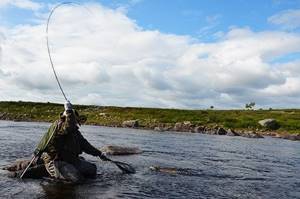
Lures
If over the course of a season the size and type of baits for fishing in a lake change little, then in a river they can undergo significant changes. High water opens up wide opportunities for the fisherman in terms of the applicability of different baits (in this context, high water means the river level at the upper border of the channel, and not the stream flowing through the forest). Fishing becomes effective and exciting precisely in the area starting from the point where the river enters the channel.

I consider wobblers to be a bait suitable in any conditions. On lakes, these baits of varying degrees of buoyancy, especially with a long-distance casting system or simply having good flight qualities, allow you to achieve good results. Most often I use a minnow with a length of 65 - 90 mm, because it is small fish that brown trout actively hunt during this period.
It's time for sinking models on rivers. They are convenient for examining the entire thickness of the flow, varying uniform wiring or drift feed with jerks of different frequencies, making upstream and downstream wiring. If the wobbler also exhibits “rolling” (swinging on its sides) during the dive, then pauses in the retrieve become mandatory - it is during a smooth fall that the brown trout often attacks the wobbler. Alternating a series of three to four jerks and a short pause for me becomes the basic feeding of the wobbler during this period.
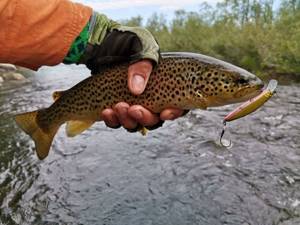
Until the water warms up above ten to twelve degrees, wobblers of acidic shades work well. I consider the most stable baits throughout the season to be those of natural colors - small whitefish, minnows or small trout.
Spoonbaits are my main bait for lakes. Weighing from 6.5 - 7 to 13 - 15 g, they allow you to fish any horizon, even in windy weather. There are not many criteria for choosing a spinner when fishing in a lake: stable performance on a slow retrieve and a pronounced “game” when shedding.
When fishing in rivers, I use spinners or as scouts for unfamiliar places, because the single spinner mounted on my spoons helps to avoid snags, or in cases where long-distance casting is important. The presence of a current requires a narrower shape of the spinner to avoid the bait from entering a corkscrew and reducing the load on the tackle when fishing against the stream.
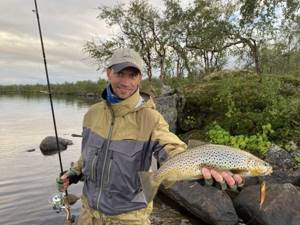
In terms of color solutions for “oscillators”, everything is very similar to the choice for wobblers. The combination of silver with blue, black or any bright color is very good at provoking fish to bite during cool water periods. A small exception would be the combination of brass with black and orange, which has shown consistent results all season. This color also works well during clear weather, when the excessive shine and brightness of the spoon often scares away brown trout.
Well, the most classic bait for brown trout is a rotating spoon, also known as a “spinner”. Ease of use and catchability have made it the No. 1 bait for many brown trout hunters. “Vertushka” combines versatility of use in different reservoirs, high visibility for brown trout - both visual and acoustic.
There are now a huge number of manufacturers on the market, offering a variety of petal shapes and sizes, core weight and color solutions. Silver and bright colors, their combination are basic colors for cool water. I noticed an interesting effect when fishing in clear weather - the blue color consistently catches well!
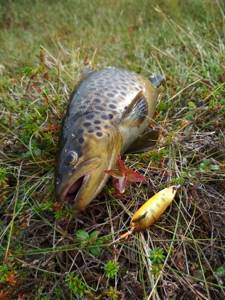
Over the past few seasons, the “spreader” in my arsenal has experienced strong competition from stickbaits - sinking, bladeless baits that look like a wobbler without a blade or a hybrid of a “spinner” and a wobbler. They are ideal for area fishing on stretches and lakes. The amazing flight qualities of the sticks make them the best choice for the longest casts, especially when fishing in the wind. These baits have practically no “game” of their own - with even wiring they only sway slightly.
The magic begins at the pause - most stickbait models have a bright “rolling” when immersed horizontally. The frequency of movements and the speed of immersion varies among different models, which allows us to choose the most optimal option for our fishing conditions. If you need to quickly fish deep areas, we use the narrowest models that ensure fast active diving.
For shallow waters, more “well-fed” options with a low dive speed are better suited. Rarely, there are also models without any “game” at all - they are designed for animation exclusively with a spinning rod.
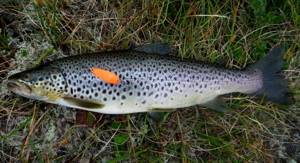
Wiring sticks can be done in two ways - “uniform” with pauses and twitching. But stickbaits - due to their design features - are contraindicated in overly strong jerks; this threatens to overlap the hook with the cord. Delicate rhythmic jerks, interrupted by pauses, seem to me to be the best wiring for baits of this type when catching active fish. If the fish is sluggish and does not show itself in any way, then a slow, even retrieve with long pauses can bring the long-awaited bite.
I noticed one pattern when fishing with sticks - brown trout attacks them very aggressively. If she can hit a “shaker” or a wobbler with her muzzle several times, then she simply demolishes a stick that falls down, as they say, such bites are very bright and will be remembered for a long time!
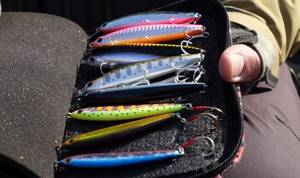
Walkers are a new direction for me in trout fishing, which needs to be worked on, but the prospects here are very good. They work both on the river and in calm water. Last year, on a shallow river, this type of bait showed excellent results. And adding to the ability to place the bait anywhere is a spectacular bite!
About the radius of invisibility of the line when fishing for brown trout
In some cases, in sunny weather and low water levels, you can use a 0.18 mm leash, but this immediately sharply increases the risk of breakage when fishing for a trophy. The length of the leash when fishing with streamers, skaters, “Chernobyl ants” and any dry flies drawing on the surface is 2.5-3 meters. This leader simply attaches to the loop on the tip of your fly line! And nothing more - everything ingenious is simple! Of course, you won't always have the perfect fly presentation as you would with a tapered leader. Sometimes a “wind-knot” will form. But the radius of the “invisibility of the cord” and the conical leash (which is visible to the fish in the same way as a fly cord) with a long retrieve will be very large. Large fish are very careful and this factor is very important when fishing for brown trout.
TROUT in the lakes of Karelia. Fishing methods for trout
Trout is a fish of the Salmon family. A typical brown trout, a migratory form, lives in the sea for up to 4 years; reaches a length of up to 1 m and weighs up to 13 kg. There are freshwater forms of brown trout - lake and river trout. Wherever there is an anadromous form, as well as where it existed during periods of colder climates, there are lake and stream forms of brown trout that mature without going to sea.
In the 90s, the Finns, together with Soviet specialists, carried out extensive research on the brown trout population that inhabits Lake Paanajärvi and breeds in almost all rivers flowing into the lake and also uses Päozero for feeding. Since it inhabits all reservoirs along the Olanga River, there is reason to call the population Olanga. It consists of a dozen different herds. The herds spawning in different rivers differ clearly in hereditary characteristics, partly in size and timing of migration.
Trout herds are replenished mainly naturally. Spawning occurs in the fall, at a water temperature of 4-6 degrees C. After spawning, the fish slide down into the lakes until the spring flood. Brown trout are usually capable of the next spawning after 2 years. There are few individuals spawning for the second or third time, on average up to 20%, which indicates, on the one hand, a huge expenditure of effort, and on the other, the impact of commercial harvest.
On the Finnish side, artificially reared 1-3 year old fry were annually released into the rivers flowing into Lake Paanajärvi to compensate for the catch. Downstream migrants leave their native threshold at 2-5 years of age. Only a couple of individuals with 100 cm kV reach migration age. threshold, i.e. the mortality rate is really high. Some of the descending downstream people remain to gain weight in Paanajärvi, while the majority continue their trek to Päozero, where downstream people from the Tavajoki and Nuris rivers also come. On abundant food, brown trout quickly gain weight. After spending 2-5 years in the lake, it begins to rise to the spawning grounds weighing 2-4 kg. From the end of the spring flood until August, the stream of brown trout moves from Päozer to Paanajärvi, where it is supplemented by the remaining stock in the lake. This herd of several thousand individuals disperses along spawning rivers from late June to September. The unwavering loyalty of females to their rivers ensures the preservation of the hereditary characteristics of the herds of each river.
A little about the methods of capture. Usually this is trolling, but it can also be casting with a spinning rod. Wobblers, professors, and other spinners of various colors are used (usually red, white, yellow shades), but in different cases they can give different results, much may depend on weather conditions and time of day. But still, as many trollers note, a small wave on the lake and cloudy weather are better for catching trout. Therefore, it is preferable to come for good fishing in early summer or autumn.
Trout are caught both in the upper layers of water (3-5 m) and at a depth of up to 20 m, often this directly depends on where vendace, which is the main food of the predator, swims.
You can see some examples of spinners in the reports of our guests, for example here
()
Brook trout is also a member of the salmon family, a freshwater form of brown trout. Found in cold and fast rivers. River trout stay near natural shelters (boulders, trees that have fallen into the water). It feeds on earthworms, insects, their larvae and young fish, especially minnows, which live in the same place as trout. They catch it with float rods for larvae and fly fishing for insects. The best time for fishing is from spring to September. The most active bite is in cloudy, cold weather. Trout is a shy fish. Therefore, the angler has to hide, hide behind bushes, behind rock ledges. Its bite is sharp and strong. Fishing is not easy, you can’t do without a landing net.
Trout meat is pinkish. It makes the soup rich and fragrant.
The history of extreme trout fishing
In addition, it is worth talking separately about fishing techniques and tactics, the use of flies, the rules for tying them and the correct landing of spotted monsters. But I will talk about this in the next article. And now I want to talk about one extreme fishing for a very large brown trout on the Kola.
It was the month of August and a very dry summer, low water levels and a half-dried riverbed in the upper reaches of the Vostochnaya Litsa River. It would seem that large fish should go into the lakes, into deeper and more familiar places. There was only half an hour left before the end of fishing and boarding the helicopter to fly to the camp. The water level is so low that the river flows as if between stones.
And now, there is a small hole on our way. The second cast is on a fly called “Kola Killer” and the surface of the water boils after hooking. One, second, third candle of unrealistically large fish for such a place. The splashes from the fish falling into the water after jumping fly to the shore and make the coastal stones wet. And then the fish rushes upstream, swims between several huge stones and entangles the cord between them. In this case, a cliff is inevitable, but it was at this moment that the monster got tired and stopped for a short break. These seconds were enough for the guide to rush into the water and free the caught cord.
Next, the fisherman jumped over the stones like a real acrobat, trying to be at a minimum distance from the fish. When the fish was almost tired and was close to the landing net, it still had enough strength to rush into the underwater grotto between the stones adjacent to each other. And at this moment, logically, there should also be a break, but the resourceful fisherman, who had all this happening right under his feet, grabbed the end of the cord with his hand. Fortunately, the brown trout was very tired, and he managed to pull it out of this ill-fated grotto by hand by the cord. When the fish was in the guide’s landing net, the cry of joy was heard by all the deer within a radius of a couple of kilometers. This is what it is like, extreme fishing and true fishing happiness. By the way, this brown trout turned out to weigh 5.5 kg and was caught with a 0.24 mm leader.
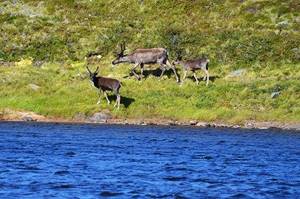
Fishing tactics
If, as the water warms up, brown trout are more often found in the surface layer, where all of its main food supply is flying insects and small fish, then at the beginning of the season it needs to be searched across all horizons. At this time, she can search for caddis flies or other invertebrates at the bottom, grab a waking frog near the shore, or chase vendace or other small forage fish in the water column.
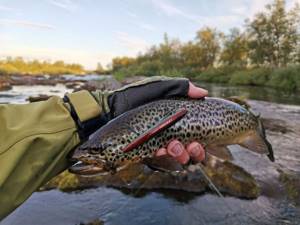
In the lake, the beginning of fishing comes down to using heavier baits. This is necessary to determine the horizon in which the fish is currently located. Such baits allow you to quickly catch large areas at all depths. As soon as it becomes clear at what depth the fish are, you can use lighter baits. This will allow you to take long pauses when fishing with wobblers and “oscillators”, because It is at these moments that brown trout often attack the bait.
Before fishing on an unfamiliar lake, it is worth studying its satellite photographs in advance in order to identify places where there is a difference in depth, extensive shallow waters and shore dumps. It also helps to build the most comfortable and rational path to the lake and choose a fishing pattern. For fishing, capes protruding into the lake with short coastal shallows are interesting. Like any other predator, brown trout likes to patrol deep dumps.
When you go to the fishing spot, you should not immediately make a long cast to the center of the lake; it is better to fish sequentially the coastal zone. After this, shift your casts to the middle of the lake. And then start casting again closer and closer to the shore on the other side of you. Such fan casts will give results more reliably than simply long casts to the center of the lake. If the point does not work, I usually move to 50 - 70 m - and repeat.
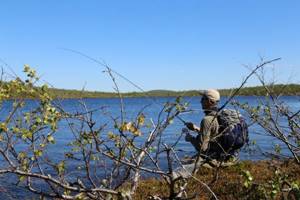
According to my observations, brown trout notice the bait from five to seven or even more meters, so we shift the point of the next cast by ten meters. If it is interested in it, the fish will show itself by attacking, or, in extreme cases, by poking the bait, or by accompanying it to the shore. In the latter case, a pause in wiring often helps. True, this technique will not work when fishing with rotating spoons; with them you need to change the speed of the retrieve. If this does not provoke the fish to bite, it is better to change the type of bait; often this change brings success.
I try to build all my fishing routes along rivers or streams with movement upstream. This has two undeniable advantages. The first is to be invisible to the fish - the brown trout stands with its head upstream, so we can get close enough to the fish to make a targeted cast to the point of interest. Sometimes a bite can occur literally a couple of meters from the angler.
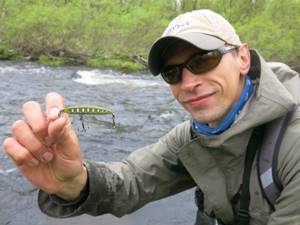
Therefore, you should not rush to throw the bait as far as possible. Here it is important to start by fishing promising places located not far from you: these are areas of calm water behind the stones next to the main stream; coastal “returns”; narrow and deep reaches; local deep pits after the rapids. Let me remind you that the ability to “read” trout sites in the river is developed with fishing experience.
After casting to the most “brown trout” points, you should definitely make several casts to, so to speak, secondary places: fast and small shifters, washouts in the banks, channel ditches. It is not known why, but it happens that brown trout are in a place that cannot be called a 100% option. Perhaps it is there that some kind of food object has accumulated en masse; from this point it is good to view the entire stream or there is good shelter.
The second point is that presenting bait moving at the speed of the stream or a little faster looks very natural for brown trout. Standing in the shelter, the fish monitors the flow and surface for passing food. Let's add here the fact that brown trout do not have much time to attack an object moving quite quickly.
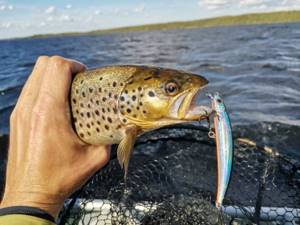
Long pursuit of prey in a fast river is not typical for brown trout. She does not like to move more than two or three meters away from the parking area, and the smaller the format of the reservoir, the shorter this distance. Therefore, brown trout resolutely attacks the bait with such a presentation. When fishing in areas where the current is smooth over a long stretch, brown trout can pursue and attack the bait throughout the entire fishing distance. This behavior will not be found in places where the flow is divided into separate streams, delimited by stones.
Interest in the bait is limited to an area of relatively clean water, and if the attack fails, the brown trout return. Juveniles are characterized by more frivolous behavior, when a brown trout, carried away by an attack, often falls into a roll from a calm drain.
June, with its water-filled rivers and streams, is an excellent time for upstream fishing with sinking wobblers. These lures perform best in fast current conditions. The absence of algae on the stones allows sinking models to be carried close to the bottom, provoking fish, and without fear of snags.
I make the first movements in an interesting area in the surface layer with dynamic animation - this way I look for active fish. If there is no reaction, I let the wobbler go deeper and add short pauses. The choice of the degree of immersion of the wobbler depends on the depth at the fishing site. Slow-sinking options are good for depths of up to a meter or a little more if there are a lot of stones in the river. I use fast-sinking wobblers in narrow and deep places - for example, in a riverbed ditch or a local hole. Also, their turn comes when fishing in long and deep stretches of rivers and streams.
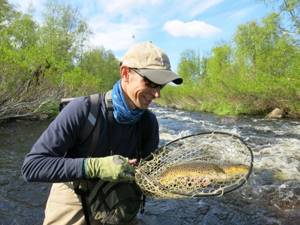
In places with variable depth, it is better to use floating wobblers with a depth of up to a meter. Driving along the current will not drive such models to the stated depth, but this is not necessary - their jerking “game” provokes fish well in relatively shallow areas. Floating models are required to have a low ascent speed so that they pause in the flow long enough and do not rise quickly to the surface.
At the beginning of the season, on large rivers that flow into large lakes and reservoirs, you can catch trout using different tactics. Just like during the salmon run, you can fish for hours, standing in one place and throwing different baits at the point while waiting for the brown trout to approach.
You can move around the river a lot, paying attention to the most pronounced places where active fish can stand. This kind of fishing has a fairly simple algorithm: several casts of the bait in which the angler is most confident, and movement to another point.
The third option would be a combination of the above tactics. Methodically fishing a point with different baits allows you not only to get a bite from active fish, but also to find the key to passive ones.
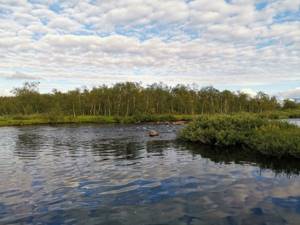
All three approaches are quite effective; which one to choose is up to everyone to decide for themselves. In this case, the choice of fishing method is determined by the character and temperament of the fisherman. Some people need constant movement and a change of scenery, while others are focused on studying all the nuances of a place and trying out baits to catch passive fish.
The most common mistake beginners make after biting trout, especially if the fish is quite large, is forced fishing. On lakes, the friction brake should be relaxed more than when fishing on rivers. At the same time, there is no need to rush to drag the fish to the shore - brown trout can easily use coastal stones, snags and algae to hide in them and thus complicate fishing.
A strong and resilient fish over a short distance can create a real attraction with somersaults, jumps and accelerations. Sometimes neither the angler, nor the rod, nor the reel have time to react to all the actions of the fish in short order - and it all ends in an unfortunate derailment or breakage.
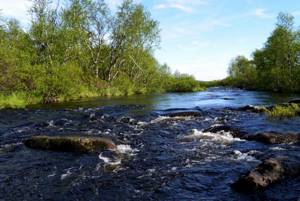
Let the fish calm down after the bite, tire it out at a medium distance - and only then carefully bring it into the landing net. For me, a landing net is a mandatory attribute of trout fishing.
Taking a fish with bait in its mouth with your hands is not the best solution; there is a high chance of getting the hook into your hand or clothing. After all, brown trout, like salmon, fights to the last, and you always need to be prepared for the fact that a seemingly tired fish will make a mighty leap to freedom in shallow water.


